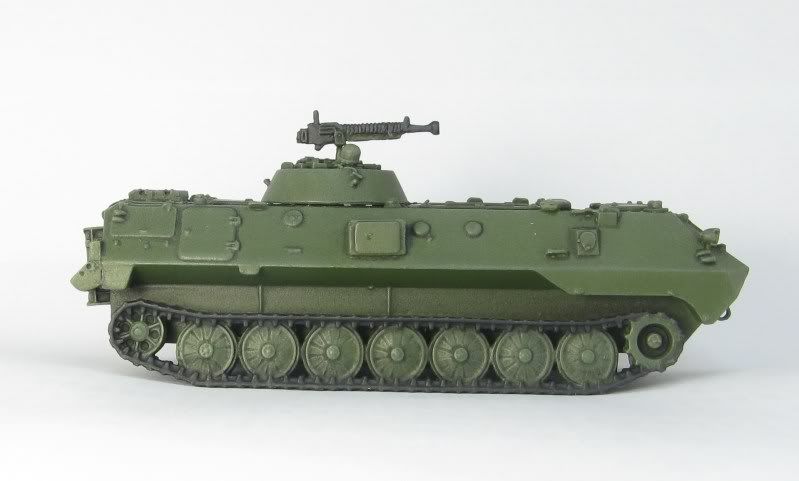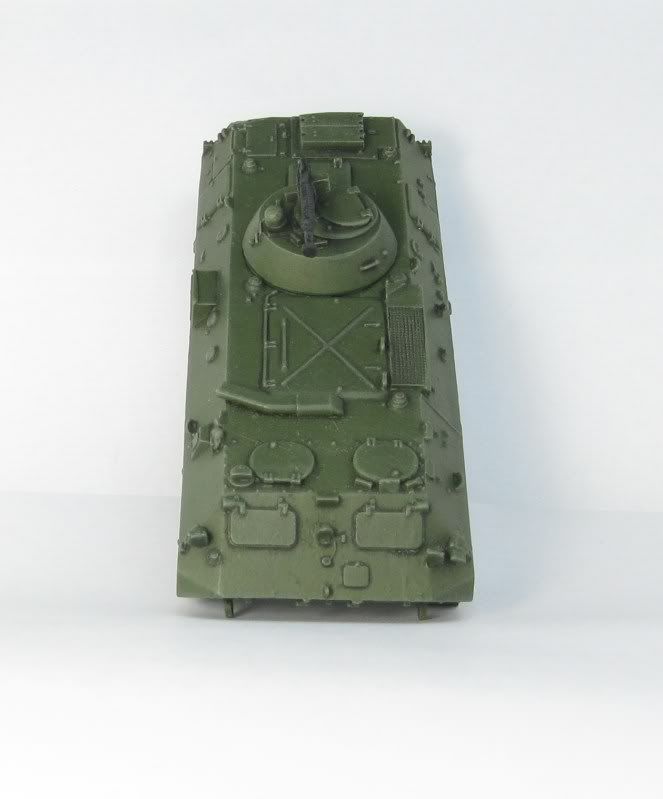The suspension consists of seven road wheels with no support rollers. The high, box-like hull has a steep glacis at the front and a flat, round turret on the rear half. The straight vertical rear of the hull contains a single exit door. A total of three or four antennas may be mounted on top of the hull. The ACRV M1974 (1) normally has a 12.7-mm DShK antiaircraft machine gun on a swivel mount atop the turret. The ACRV M1974 (2) turret mounts a laser rangefinder, optical observation devices, and associated fire-control equipment. The ACRV M1974 (3) may mount a 12.7-mm machine gun and probably contains a digital fire-direction computer. The ACRV M1974 (1) and (2) also vary from the ACRV M1974 (3) by having a rectangular box projecting from the right side of the hull, just below the turret.
The artillery command and reconnaissance vehicle (ACRV) Ml974 is known to be deployed in three versions. All three have the same basic chassis as the 122-mm self-propelled howitzer 2S1. The three versions of the ACRV are deployed in self-propelled howitzer battalions:
ACRV M1974 (1) IV13 (Battery Fire Direction Centre) remains in the battery firing position as the battery FDC. The battery FDC is manned by the battery senior officer (platoon leader of the first firing platoon), assisted by (manual) fire direction computation and communications personnel. It has direct radio communications with the battery command observation post (COP), the battalion COP, and the battalion FDC. The battery senior officer relays firing data to the SP howitzers.
ACRV Ml974(2) IV14/IV15 (Battery and Battalion Command Vehicle) is used by both battery and battalion commanders as a COP. It does not remain in the firing posit ion, and in most cases it is collocated with the COP of the supported manoeuvre unit commander. The artillery commander decides how to attack targets of opportunity and targets relayed to him by the supported manoeuvre unit. He is assisted by target acquisition, (manual) fire direction computation and communications personnel in the COP. The battery COP has radio links to battery firing positions and to the battalion COP. The battalion COP also has direct radio communications with battery firing positions.
ACRV M1974 (3) IV16 (Battalion Fire Direction Centre) functions as the battalion FDC and is manned by the battalion chief of staff, fire direction computation, and communications personnel. It most likely carries the one electronic field artillery computer available to each battalion Battery fire direction personnel probably will receive from the battalion FDC fully computed firing data that is ready to be passed to the SP howitzers.
MODEL
I got my hands on a MMS ACRV (and I suspect it's an ACRV-1). Like all MMS kit, its a hefty beast that would break your toe if you accidently dropped it. Mine didn't come with a 12.7mm AA MG, so I added a 'spare' Liberation Dushka I happened to have lying around.
PAINTING
Same old same old....
I needed this for a command vehicle for a scenario I've written. It will basically (I imagine) be pretty much a large target for an SAS missile, rather than actually contributing much in the game. But that doesn't mean it can't look nice!
So without further ado - here's a couple of photos of my ACRV-1 or 2 or 3

Side shot

Top shot
Finally - here's the one youtube video clip I could find on the ACRV-1
have fun
Richard
No comments:
Post a Comment